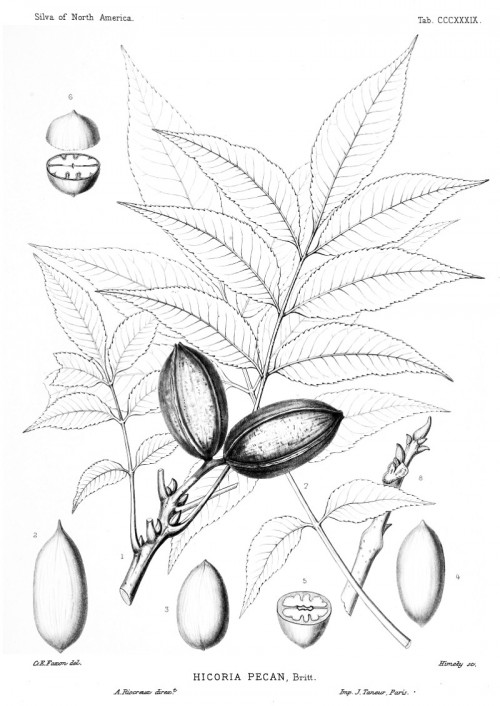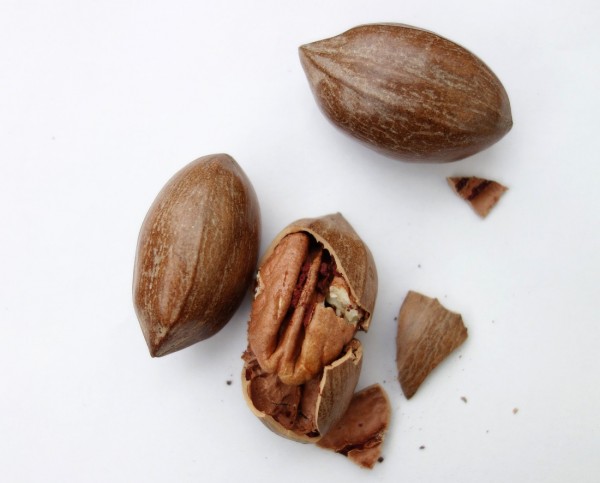Dies ist eine alte Version des Dokuments!
Carya illinoinensis (Wangenh.) K. Koch - Syn.Carya illinoensis (Wangenh.) K. Koch; Hicorius pecan (Marshall) Britton; Carya pecan (Marshall) Engl. & Graebn. - Juglandaceae - pecan, Pekannuss, Hickorynuss (-baum)
Tree, native to Northern America, cultivated elswhere for its edible nuts; leaves compound, up to 35cm long, leaflets usually 9-13, elliptic-lanceolate, glabrous or glabrescent; male spikes up to 14 cm long; nuts ovoid-ellipsoid, 3-5×2-3cm, husk without prominent wings.
http://www.efloras.org/florataxon.aspx?flora_id=2&taxon_id=210000185
„A pecan, like the fruit of all other members of the hickory genus, is not truly a nut, but is technically a drupe, a fruit with a single stone or pit, surrounded by a husk…
The seeds of the pecan are edible, with a rich, buttery flavor. They can be eaten fresh or used in cooking, particularly in sweet desserts.“
http://en.m.wikipedia.org/wiki/Pecan
The volatile compounds whose concentrations increased the most during storage of pecan nuts were identified as hexanal, dodecane, tridecane, and tetradecane.
[Correlation of objective and subjective measurements of pecan kernel quality., Forbus, W.R., Senter, S.D., Lyon, B.G., Dupuy, H.P., Journal of Food Science, Vol.45(5), 1980, 1376-1379]
Pecan seeds show high amounts of lipid (55-75%), thus the majotity of the volatiles identified are breakdown products of unsaturated fatty acids. Pecan seed oils contain alkanes (C5-C14), aldehydes (C2, C4-C10), ketones like acetone and 2-heptanone, and aromatic compounds like toluene, propylbenzene, benzaldehyde, and acetophenone.
[Flavor and Volatile Compounds in Tree Nuts, Cadwallader, K.R., Puangpraphant, S., in Tree Nuts: Composition, Phytochemicals, and Health Effects, C. Alasalvar, & F. Shahidi (Eds.). CRC Press: Boca Raton, FL., 2009, 109-126]
„Volatile components formed during the roasting of pecan kernels originate mainly via lipid oxidation/degradation and Maillard/Strecker reactions. Of particular importance to the sweet and nutty aroma of roasted pecans are 2-acetyl-1-pyrroline, 2-propionyl- 1-pyrroline, 4-hydroxy-2,5-dimethyl-3(2H)-furanone, 3-methylbutanal, 3-ethyl-2,5- dimethylpyrazine, 2-ethyl-3,5-dimethyl-pyrazine, 2,3-diethyl-5-methylpyrazine, 2- pentylpyridine, and 2-acetyltetrahydropyridine.“
[Changes in the aroma components of pecans during roasting., Cadwallader, K., Kim, H., Puangpraphant, S., Lorjaroenphon, Y., W: Expression of multidisciplinary flavor science., Red. I. Blank, M. Wüst, C. Yeretzian. Zürcher Hochschule für Angewandte Wissenschaften, Winterthur, Schweiz, 2010, 301-304]

Sargent, C.S., The Silva of North America, vol.7, t.339 (1898) [C.E.Faxon]
http://plantgenera.org/species.php?id_species=207477

